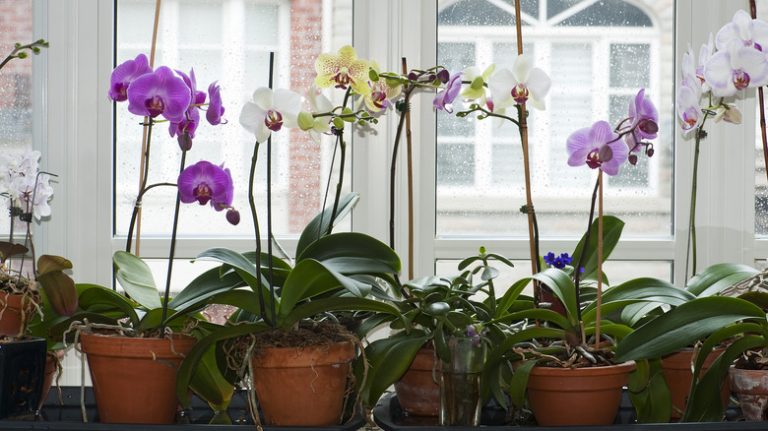Growing a garden can be a long, complicated process that can be tiring both mentally and physically. From choosing a location, selecting which type of flowers to grow, and learning the needs of each of those flowers, it can become a bit overwhelming. However, there are many popular flowers that you can start with, one of those being anemone flowers. Caring for these flowers usually only requires sunlight and water. However, just like any other plant, there’s a ton to know about anemone flowers.
Originally harvested from the ranunculaceae “buttercup” family, anemone flowers are most commonly known as “wind flowers.” Southern Living notes that this is due to the word “anemone” stemming from the Greek term that means “winds.” As per Interflora, these remarkable flowers close up at night to protect themselves from the cold. In the morning, when the sun begins to reappear, they then reopen to take in the fresh sunlight.
Anemone flowers are keen to warm temperate areas and are mostly found in North America, European countries, and around Japan, according to Home Stratosphere. Out of over 120 variants, there are three main types consisting of spring flowering, fall flowering, and tuberous Mediterranean. While the majority of anemone flowers resemble each other, they can come in many different shapes, sizes, and colors.
Blanda anemone

Blanda anemone flowers are one of the most popular types as they are known to look very similar to daisy flowers. Longfield Gardens recommends planting these in the fall as they’ll be ready to bloom in the spring. They typically should be planted in partial sunlight areas with moist soil. However, they can also be planted in full sunlight if need be, but will need constant watering to keep the soil moist.
Only growing up to 6 inches tall, they tend to go dormant after blooming. Blanda anemones do multiply rapidly which should be considered if growing a small garden.
Bordeaux anemone
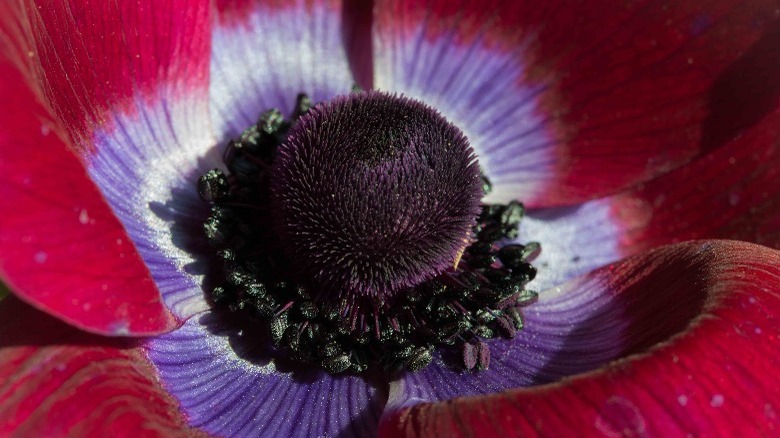
Another equally popular flower type are bordeaux anemone flowers. Even though these beautiful flowers are typically grown in a garden, they can also be grown in containers and used as cut flowers as well. Direct Bulbs suggests soaking the bulbs from the flower overnight in warm water for about 12 hours prior to planting the next day.
Bordeaux anemone flowers can be grown in partial sunlight, but thrive much better in full sunlight. They tend to grow up to 14 inches tall and typically bloom in the late spring and earlier summer.
Bressingham glow anemone
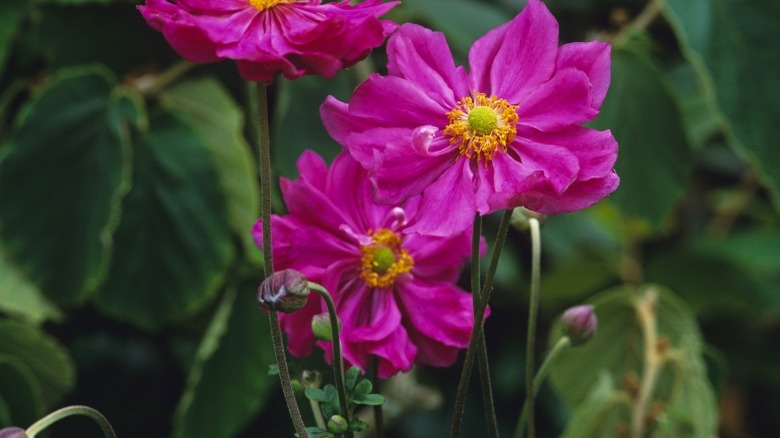
Gardens by Design/Shutterstock
One of the tallest anemone flowers is the bressingham glow anemone. Ranging anywhere from 2 feet to 4 feet in height, these flowers usually bloom mid summer to mid fall. Backyard Gardner, suggests planting these in the spring and fall seasons.
Bressingham flow anemones are almost always pink and thrive best in an equal partial sun and partial shade setting. They’re best kept in moist soil and can be grown both in the ground and in a container.
Dreaming swan anemone
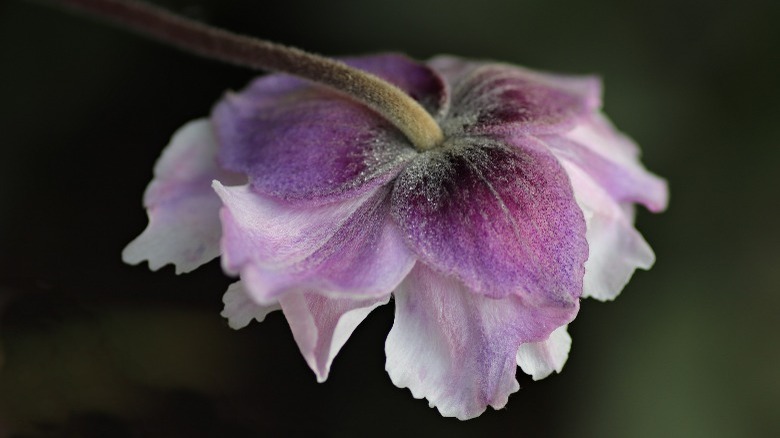
gardenia68/Shutterstock
A uniquely named flower is the dreaming swan anemone flower. According to Walter’s Garden, these flowers can reach a height of around 24 inches and can spread just as much as well.
Blooming from late summer to early fall, these plants are usually a variant of different shades of white. They can be grown in full sun or in partially sunny areas. Like some others, these anemone flowers attract butterflies and are resistant to both deer and rabbits.
Hollandia anemone

SergeyMarina/Shutterstock
Unlike some, hollandia anemone flowers thrive best in direct sunlight. According to Gardenia, they can grow to have a height of 16 inches and can be cultivated easily in sandy areas as well as in containers. These plants are versatile and can be planted throughout the year, but their corms should be placed in water for a few hours prior to sowing.
Most commonly known for bright red petals, these flowers also have a dark center. While attracting butterflies, they are also resistant towards deer and other animals.
Japanese anemone

Jackie Tweddle/Shutterstock
Much like its name, Japanese anemone flowers have been in and around Japan for hundreds of years. Blooming in the late summer and early fall, these flowers are known to reach a peak height of 18 inches, via Gardner’s Path. However, according to Gardenia, it typically takes one to two years for them to fully grow. Yet, once they are grown, they tend to multiply rapidly.
Japanese anemones are best kept in partial sun, but can tolerate in full sunlight as long as they’re constantly watered to keep the soil moist. While they act as an attraction to butterflies, they’re also resistant to rabbits, deer, and other insects.
Meadow anemone

Alexandra Kovaleva/Shutterstock
Growing anywhere from 12 up to 24 inches, meadow anemone flowers are most known for their capacity for quick and rapid spreading. Per Gardener’s Path, they typically start to bloom in mid spring to early summer.
Furthermore, like most anemone flowers, they can be grown in both full or partial sun and can be commonly found near ponds, lakes, and other water sources. These flowers are most popular in the North America region and are usually free from diseases and pests including deer.
Mona Lisa anemone
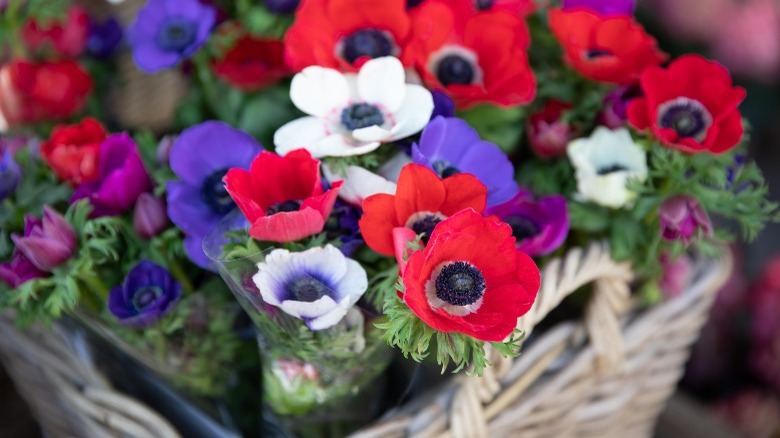
Victoria Kurylo/Shutterstock
Primarily known for its unique name, the Mona Lisa anemone flowers are some of the most popular. Usually, they bloom in the fall and early spring and can reach a height of up to 18 inches tall.
Ball Seed suggests that these flowers should be spaced out 6 to 8 inches apart from one another. They can be planted in an equal partial sun and partial shade area and are one of the lowest maintenance anemone flowers.
Mr. Fokker anemone

Mary Terriberry/Shutterstock
Mr. Fokker anemone flowers are most famous for their blue to purple color. Typically blooming in the mid to late spring, they can reach a peak height at anywhere from 6 to 9 inches, notes The Spruce.
They thrive perfectly well in full sun exposure, but like most other plants, their soil must be kept moist. According to Longfield Gardens, these flowers are known to attract butterflies and can also be grown in containers as well as be used for cut flowers.
Pamina anemone
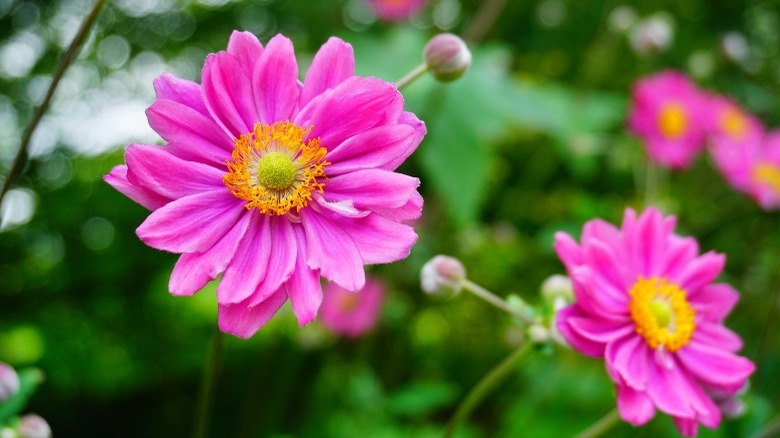
Mariola Anna S/Shutterstock
One of the brightest and cheerful anemone flowers is called a pamina anemone. Perfect for garden planting, these flowers can grow anywhere from 12 to 18 inches tall. They also look great as cut flowers too.
Gardenia notes that these flowers are some of the longest blooming flowers, lasting from late summer and through the early fall seasons. They can be planted in full sun or part sun, but their soil must be kept moist. While attracting butterflies, they’re resistant to insects, diseases, deer, rabbits, and other critters.
Pocahontas anemone

Ian Grainger/Shutterstock
Uniquely named, Pocahontas anemone flowers are strictly pink in color and have a bright yellow center. Great for cut flowers or grown in containers, they typically grow up to around 18 inches tall and can be in both full sun or partial sun.
Per Bluestone Perennials, they tend to bloom in the mid summer into early fall. While attracting butterflies and resisting insects and critters, these flowers are also known to be resistant to salt as well. They require very little maintenance and are great for gardening beginners.
Rainbow pastel mix anemone

liu yu shan/Shutterstock
Another uniquely named plant is the rainbow pastel mix anemone flower. Similar to poppy type flowers, they have a variety of color, and can reach a height of up to 12 inches tall; they bloom in the mid spring and summer seasons.
The Flower Bulb Farm suggests planting their bulbs in the spring or fall, 6 inches apart, and 2 to 3 inches in the ground. The upkeep is pretty easy as they thrive perfectly well in full sunlight. Oh, they’re also great for cut flowers as well.
White splendor anemone
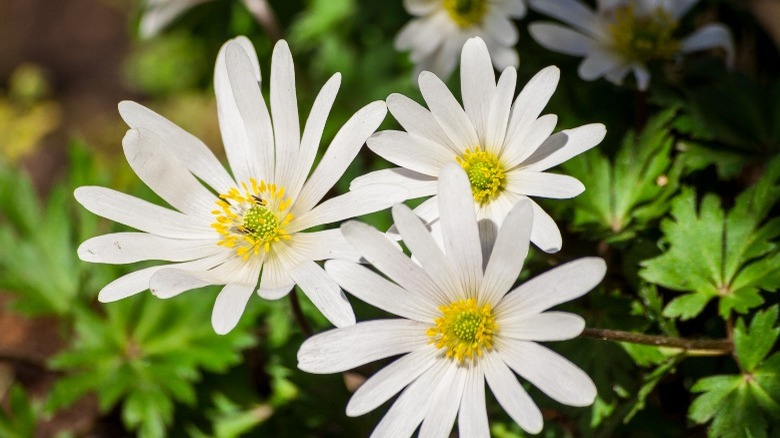
EvaHeaven 2025/Shutterstock
White splendor anemone flowers, like most, can thrive in both full sunlight and partial sunlight. Growing to about 6 inches tall, these plants must be spaced about 4 inches apart, and can also be grown in containers.
Typically, they bloom in the late spring into the early summer and are known to go dormant afterwards. Bluestone Perennials recommends putting the flower’s tuber in water overnight prior to sowing. While they act as an attractant to butterflies, they’re also resistant to deer.
Wild swan anemone

Lauren Bilboe/Shutterstock
Very similar to their sister dreaming swan anemones, wild swan anemones can typically grow up to 24 inches tall. They have a much longer flowering season than most with blooming starting in late spring and lasting all the way through the end of fall.
Gardenia says that these flowers can be planted in both full sun or partial sun, but the soil must be kept moist. They also suggest using some sort of wind protection. These can also be used as cut flowers and are one of the easiest anemone flowers to grow.
Wood anemone

simona flamigni/Shutterstock
According to Wildflower, wood anemone flowers grow up to a height of about 12 inches tall and typically bloom in early spring, throughout mid and late spring, and into early summer. While the color of this flower can sometimes vary, they’re typically found in the North America region and around woodland areas, hence the name.
They should be kept in full or partial shade and the soil must remain moist. Unlike the majority of flowers, after the flower has bloomed, it disappears and does not return the next spring.




